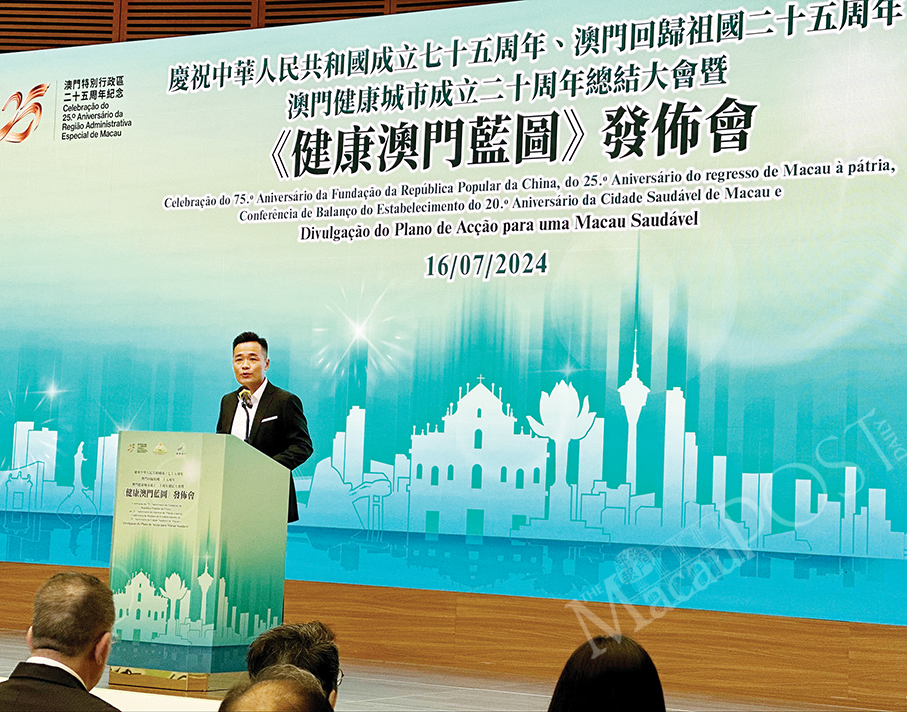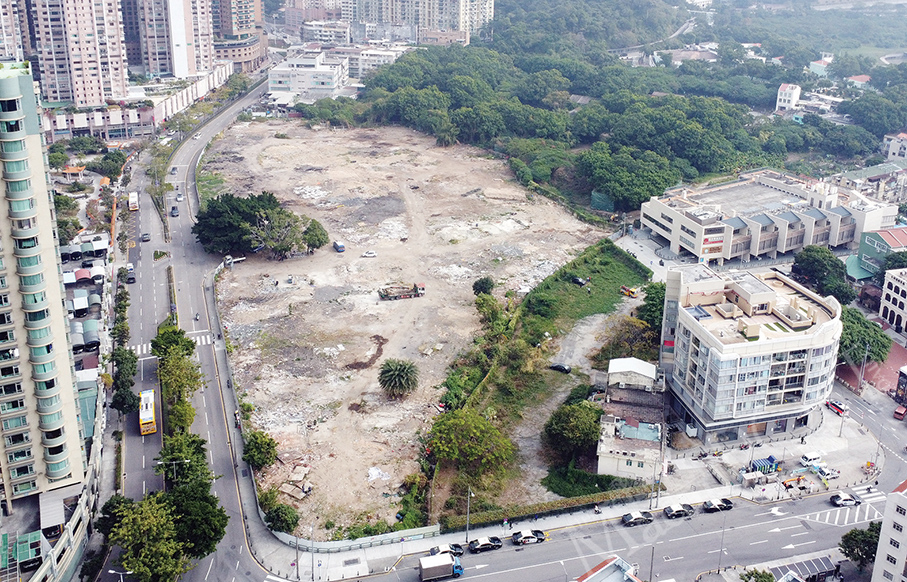The government launched yesterday its “Healthy Macau Blueprint”, and Health Bureau (SSM) Director Alvis Lo Iek Long said in a speech at the launching ceremony that the blueprint, characterised by “long-term planning, strengthening top-level design and mobilising community-wide participation”, sets out in detail 20 specific objectives and 52 assessment indicators to be achieved by 2030, covering areas such as health risk factors, mental health, chronic diseases, and infectious diseases.
It is hoped that by 2030 Macau can achieve the overall targets of improving the whole population’s health literacy, basically popularising healthy lifestyles, controlling major chronic diseases, and sustainably improving residents’ quality of life, Dr Lo said.
He added when talking to the media after the ceremony at the Macau Science Centre in Nape: “This blueprint not only provides goals and objectives, but also encourages different stakeholders – individuals, communities and the government – to work together to achieve the goals of Healthy Macau by 2030, in which the government will continue to introduce measures that are conducive to the health of the population as a whole, such as its tobacco and alcohol prevention and control measures, while also continuing to optimise its current medical and healthcare services, both public health and community healthcare and specialist healthcare services. In addition, at the community level, we hope that all sectors of society will cooperate with the implementation of the blueprint to create a healthier working, living and learning environment for our residents so that our environment is more conducive to the practice of healthy behaviours and the cultivation of healthier lifestyles.”
According to Dr Lo, the blueprint was formulated in accordance with the “Outline of the Healthy China 2030 Plan”, with reference to the global strategies and action frameworks developed by global organisations, such as the World Health Organisation (WHO), and taking into account the actual situation of Macau. Focusing on the health of the population as a whole, the blueprint combines resources from the fields of health, education, culture and sports, and also integrates aspects of a healthy lifestyle into public policies to complement the government’s development of the big health industry.
The ceremony was also attended by Secretary for Social Affairs and Culture Elsie Ao Ieong U and Liaison Office of the Central People’s Government in the Macau Special Administrative Region (MSAR) Publicity and Culture Department Director-General Wan Sucheng, among other senior government officials.
3 major health challenges
The blueprint points out that Macau residents are facing three major health challenges in the face of multiple social factors, such as urban development, an ageing population and changes in lifestyles – “Poor Diet and Lack of Exercise”, “Increased Risk of Chronic Diseases such as Obesity, Hypertension, Diabetes and Cancer”, and “Rising Demand for Healthcare”.
According to the blueprint, the findings of the Health Behaviour Survey of Secondary School Students in Macau in the 2022-2023 School Year show that most of the respondents spent their leisure time on various types of sedentary behaviours, with mobile phones and computers used for surfing the internet as the major ones, 90 percent of them failed to meet the standard of daily physical activity, and more than 70 percent spent most of their time on electronic screen entertainment outside school hours. In addition, about 40 percent of the respondents did not consume the required amount of fruit and vegetables in line with the WHO recommendation of at least 400 grams, or five portions, of fruit and vegetables per day, and their capacity for active health management needed to be improved.
According to the Survey on Public Health and Medical Attendance launched in 2022, quoted by the blueprint, about one-quarter of the respondents aged 16 or above suffered from chronic diseases, commonly in the form of hypertension and diabetes mellitus, and the demand for healthcare continued to rise, with more than 80 percent of deaths in Macau caused by chronic diseases.
According to the 2016 Macau Health Survey, about one in four adult local residents suffered from hypertension, whose prevalence was quite high, SSM Health Promotion Division Chief Wong Weng Man said during the ceremony’s briefing about the blueprint, adding that “as for the awareness rate is concerned, only seven out of 10 patients know that they have hypertension, and about three out of 10 patients may not have taken any steps to control their blood pressure and may have only gone to the doctor when they had symptoms and realised they had it, which may have been at a more serious stage by then”.
According to the findings of a study conducted by a Hong Kong academic institution last year about the Macau Public Health and Clinical Services Programme, the demand for inpatient services among the elderly in Macau was six times higher than that of other age groups, the blueprint cited the survey as pointing out.
3 major policy directions, 3 action strategies
The blueprint proposes three major policy directions, according to Dr Lo: “Firstly, to move the gateway before identified risks occur: apart from continuing to consolidate and optimise current healthcare services, the gateway to intervention will be shifted to prevention, early detection, early diagnosis and early treatment of diseases; secondly, resource allocation: more resources will be allocated to the community, on the one hand, to collaborate in the prevention and control of chronic diseases through the collaboration of public and private healthcare institutions and, on the other hand, to create an environment conducive to residents’ health through cooperation between organisations, civil associations, businesses and schools; thirdly, conceptual change: residents will be encouraged to change from passively receiving healthcare services to proactively taking measures to prevent the occurrence of diseases and to do a good job in self-management of chronic diseases.”
As for the three major action strategies, according to Dr Lo, firstly, the government needs to formulate health-friendly public measures and optimise the integrated medical and healthcare system; secondly, the community needs to build a health-supportive environment and mobilise the community to create a healthy living environment through programmes such as Healthy Enterprises, Healthy Campuses and Healthy Restaurants; and thirdly, residents need to practise healthy behaviours, including abstaining from smoking and alcohol consumption, exercising and dieting, sleeping enough and reducing stress, and raising awareness and capacity for proactive healthcare management.
In terms of mental health, Dr Lo urged members of the public to create a caring environment in the community together with the government: “If we find that our friends are emotionally disturbed, we have to be more caring and listen to them. As for individuals, we hope to enhance health education at different levels so that our residents can learn how to relieve their emotions when they face stressful situations. As for the personal aspect, we hope to enhance health education through different levels so that when our residents face stressful situations, they can learn how to soothe their emotions.”
Dr Lo pointed out that mental health services have been integrated into the community’s medical and health service system, in which 16 psychiatrists have been posted to local health centres to commence training to strengthen the capacity of health-care personnel there in handling mental health cases.

Health Bureau (SSM) Director Alvis Lo Iek Long delivers a speech during yesterday’s launching ceremony of the government’s “Healthy Macau Blueprint” at the Macau Science Centre in Nape. – Photo: Yuki Lei

The launching ceremony attendees perform five-minutes of physical exercise yesterday. – Photo: Yuki Lei









